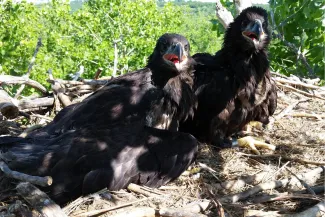
Many wildlife enthusiasts flock to our state's lakes and major rivers each winter for the chance to see a mature bald eagle flying overhead or perched along the bank. While a majority of these birds are migratory - flying south to take advantage of Oklahoma's typical mild winters and returning to northern states for the summer - more than 100 pairs of bald eagles stay in Oklahoma to nest and raise their young. Earlier this year, the Oklahoma Department of Wildlife Conservation partnered with the U.S. Geological Survey, our nation's largest water, earth, and biological science agency, to find out where Oklahoma's eagles go and ways to better manage our eagle population.
To track eagle movements, the USGS attached solar-powered cellular transmitters to eagles with a "backpack" harness. The harnesses were positioned over the birds' shoulders and under the wings. Transmitters can be fastened to both adult birds as well as 8-week-old chicks; researchers focused on nestling eagles for this project.
More than 30 bald eagle nest trees were identified in Central Oklahoma for the research project with the help of Wildlife Department employees and the Oklahoma Highway Patrol's Air Support team. Researchers climbed nine of the nest trees, which sheltered 15 chicks. Seven of the chicks were at a suitable age, with well-developed muscles and flight feathers, to receive a transmitter.